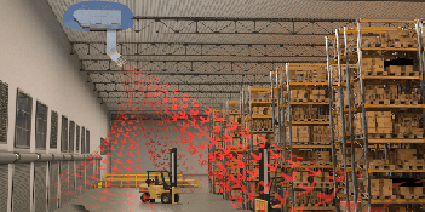Benefits of Heating Warehouses with Direct Gas-Fired Equipment

Direct gas-fired equipment has been used for many years in industrial make-up air applications. Benefits including 92% thermal efficiency, low first cost, and compact footprints make direct gas-fired equipment the ideal choice. For these same reasons, direct gas-fired equipment is also a great fit for space heating in warehouses and distribution centers.
Warehouses and distribution centers are challenging spaces to heat during the winter. Numerous dock doors result in high amounts of cold air infiltration, tall ceilings in these facilities cause the air to “stratify” with the warm air rising to the ceiling and cool air falling to the floor and large amounts of outside air must be delivered to the space to improve indoor air quality (IAQ) and meet code requirements. Direct gas-fired equipment is the ideal solution to meet these challenges.
Warehouses must be ventilated at a minimum of 0.06 cfm/ft2 per the International Mechanical Code and ASHRAE 62.1 – Ventilation for Acceptable Indoor Air Quality. At first glance, this minimum ventilation requirement may seem insignificant, but the amount of energy to heat the ventilated air to the space temperature can be 20% – 30% of the overall heating load for a typical warehouse. Direct gas-fired equipment delivers this needed outside air to the space much more cost effectively than other technologies. Compared to indirect gas-fired equipment, direct gas-fired equipment space heating units require 13% less natural gas with an initial equipment cost of 30% less.
Cold air infiltration through dock doors often is the largest portion of the heating load for warehouse facilities. Additionally, infiltration results in cold drafts that make loading dock areas uncomfortable and displace warm air in the space forcing it to the ceiling. Dock door shelters reduce the infiltration, but even with high-performing dock shelters, a significant amount of air will get into the building at average wind speeds. Direct-fired equipment can minimize infiltration by providing outside air to pressurize the building space. Positive building pressure minimizes infiltration at dock doors resulting in more comfortable spaces.
Stratification is another critical consideration for heating a warehouse. Stratification occurs when the warm air in the space rises to the ceiling. It is common to see warehouse facilities with 40 ft tall ceilings and floor-to-ceiling temperature gradients of 10F or more. When this occurs heat loss through the roof increases significantly resulting in increased operating costs. To avoid stratification, direct-fired equipment is commonly applied with a relatively high-velocity discharge diffuser (Figure 1). The diffuser throws the air at a downward angle providing effective mixing and even heat distribution within the space.
 |
| Figure 1 -- Direct-fired equipment along with a high-velocity discharge diffuser provide effective mixing and even heat distribution. |
To optimize direct gas-fired equipment for space heating in warehouses it is generally applied in two configurations, 100% outside air with high discharge temperatures and recirculating configurations.
Units featuring 100% outside air maximize the amount of heating capability of the outside air delivered to the space. Outside air is necessary for ventilation to maintain IAQ and pressurize spaces to minimize infiltration. The air must be heated to space temperature at a minimum. Rather than delivering the air at a similar temperature to the space, it is very cost effective to increase the heating capacity of a direct gas-fired unit to allow an elevated discharge temperature of 140°F (Figure 2). This temperature maximizes the heating potential these units can provide and results in one of lowest first cost solutions for heating large warehouse facilities.
 |
| Figure 2 -- Increasing the heating capacity of 100% direct gas-fired units to a discharge temperature of 140°F is very cost effective. |
Recirculating direct gas-fired units are commonly referred to as 80/20 units because they typically are applied at a minimum of 20% outside air. Because these units only provide 20% outside air, equipment safety standards limit the maximum discharge temperature to around 100°F in most applications. This means the units must provide more airflow to heat the space than 100% outside air units, typically are larger and have a higher initial cost. The key advantage of these units is the ability to adjust the amount of outside air delivered to the space. This allows for control of building pressure, minimizing infiltration, and maximizing indoor comfort levels. Additionally, only the necessary amount of outside air needs to be delivered to the space reducing energy consumption. (Figure 3)
 |
| Figure 3 -- 80/20 units control building pressure, minimize air infiltration and maximize indoor comfort levels. |
Direct gas-fired equipment is a proven cost-effective and efficient solution for heating and ventilating large warehouse and distribution. Recent advances in supply fan technology further enhance the efficiency of this equipment (see “The Energy Savings Revolution in Make-up Air” for more info). Learn more about how to heat warehouses and distribution centers with direct gas-fired equipment.
Make-up Air Warehouse Ventilation

from